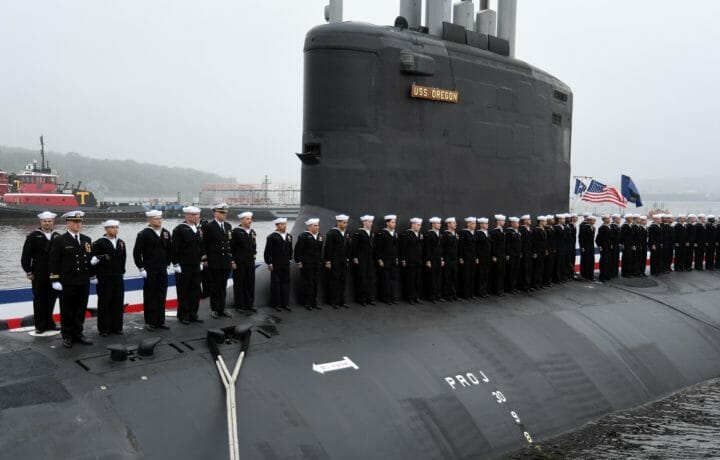Last month, the U.S. Navy commissioned the fast-attack submarine USS Oregon (SSN -93) at a ceremony at the Naval Submarine Base New London, CT. The Virginia-class boat, which had been originally christened in 2018, officially joined the fleet on May 28, and became the first Navy vessel named after the Beaver State in more than a century.
“Oregonians are deeply honored that the 20th Virginia-class submarine will bear the name of our state,” said Gov. Kate Brown of Oregon, the ceremony’s keynote speaker.
The Memorial Day weekend event for USS Oregon was also the first in-person submarine commissioning since before the outbreak of the Covid-19 pandemic, when USS South Dakota (SSN-790) was commissioned on February 2, 2019.
“This is the first in-person commissioning ceremony of a submarine in more than three years, and that’s a long time to delay celebrations like this one,” said Tommy Ross, performing the duties of Assistant Secretary of the Navy for Research, Development and Acquisition. “As we honor the fallen this Memorial Day Weekend, I’d also like to remember the many service members who made the ultimate sacrifice to keep this great nation free.”
SSN-793 is only the third U.S. Navy vessel launched to bear the name Oregon, and as noted, the first in more than a century. The first, named after the Oregon Territory before Oregon became a state, was a brigantine in service from 1841-1845; while the second was an Indiana-class battleship commissioned in 1896 and ultimately decommissioned for the final time in 1919.
The Navy’s Fast Attack Subs
The Virginia-class submarines first entered service in 2004 to replace the aging Cold War-era Los Angeles-class submarines, and the new class was designed to incorporate the latest advancements in stealth and weapons systems technology. The boats can handle a variety of open-ocean and littoral (shallow water) missions and this includes anti-submarine warfare (ASW), anti-surface warfare (ASuW), strike warfare, irregular warfare, intelligence, surveillance, and reconnaissance (ISR), and mine warfare.
The Virginia-class boats are currently the U.S. Navy’s primary submarine for land, surface and anti-submarine attack missions, and its armaments include cruise missiles and torpedoes. It also has large lock-in/lock-out chambers that allow Navy SEALs to operate from the boat, while there are future plans for it to be used to launch underwater drones. Instead of the traditional periscopes this class of submarines utilizes two photonics masts that host visible and infrared digital cameras atop telescoping arms.
There are currently 22 Virginia-class submarines in active service out of the originally planned 66 boats – and current plans call for the Navy to acquire at least an additional 34. General Dynamics Electric Boat, Groton, Connecticut; and Huntington Ingalls Industries, Newport News, Virginia are the designers and builders of the submarines – while Newport News Shipbuilding, Newport News, VA also constructed three of the submarines that are now in service.
Second of the Block IV Boats
USS Oregon is also the second Block IV Virginia-class submarine to enter service. The Block IV boats incorporate design changes that were focused on reduced total ownership cost. By making these smaller-scale design changes to increase the component-level lifecycle of the submarine, the U.S. Navy was able to increase the periodicity between depot maintenance availabilities and increase the number of deployments. The main improvement of the Block IV over the preceding Block III is the reduction of major maintenance periods from four to three, increasing each boat’s total lifetime deployments by one.
USS Vermont (SSN-792) became the first Block IV boat to enter service in April 2020. Eight additional Block IV Virginia-class submarines are now under construction; while production has already begun on the Block V variants.
The planned 10 Block V boats will incorporate the Virginia Payload Module (VPM), which would provide guided-missile capability to fill a crucial role when the U.S. Navy’s current SSGNs (modified Ohio-class) are retired from service.
The Block V submarines are expected to triple the capacity of shore targets for each of the subs. With the addition of the VPM, the submarines of the Block V will be increased in length, from 377 ft (115 m) to 460 ft (140 m), and displacement, from 7,800 tons to 10,200 tons. It would also make the Block V the second-largest US submarine, behind only the Ohio-class (at 560 ft; 170 m).




